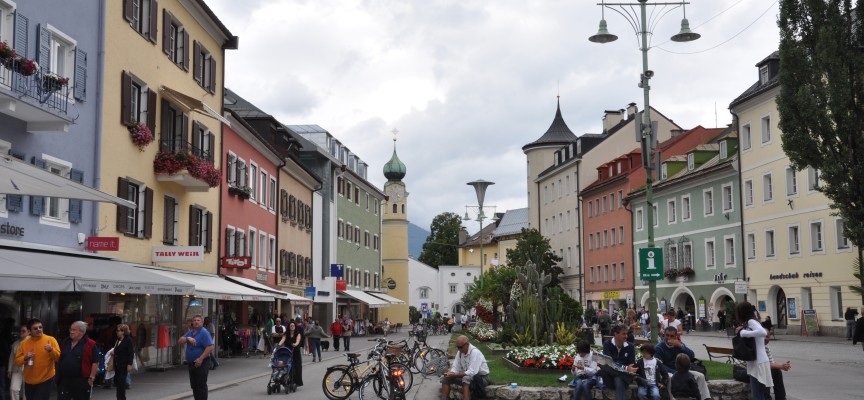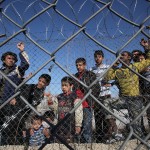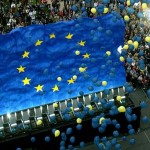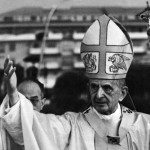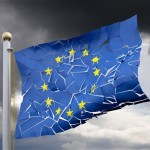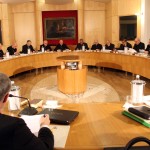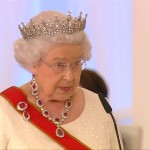It should be duly noted that, at that time, Europe was divided and wounded by an “Iron Curtain” that crossed it from north to south just in its central part. Communication and dialogue were very difficult if not impossible; in short, the Central European idea might seem a veritable utopia. But believing in “dreams” and pursuing them with passion and tenacity has been the real strength of this unique association.
From the beginning, the Association is characterized by a mission of social solidarity that could strengthen the bonds of brotherhood and coexistence with neighbouring peoples, as stipulated in its Statute, above the old borders as well as the new ones, and then expand project horizons to the whole of Central Europe.
Thus was born the Feast of the Peoples of Central Europe, an event that has summoned for nearly forty years tens of thousands of people from various Central European countries, attracting the attention of major international press and, between surprise and disbelief, even of several international institutions. A fundamental contribution to the European role of the Association, however, is given by the celebrations of the Day of Remembrance that, since 1990, are being held in rotation in the various capitals of Central Europe in memory of May 2nd, 1989, when the governments of Austria and Hungary brought down the “Iron Curtain”, cutting the barbed wire that separated them after centuries of common life. Since that all-important day, the real process of European unification has started, and in this extraordinary journey executives of the Association understand they can offer a unique and spontaneous contribution, that eventually does not come from above but from below, from a clear conscience and will of the people. The instrument that proves to be the most suitable is that of international meetings: institutional tables which can lead to an effective parallel diplomacy in the construction of more and more engaging and convincing relations. That decision, accompanied by an incessant and discreet professional work, has undoubtedly strengthened the image of reliability and credibility of our action, so much so that today we are definitely a party that enjoys a peculiar regard and esteem in several European Chanceries and cultural institutions of Central-Eastern Europe, a kind of “diplomatic checkpoint” with an interesting feature of private diplomatic agency.
Va doverosamente ricordato come, all’epoca, l’Europa fosse divisa e ferita da una “cortina di ferro” che la oltrepassava da Nord a Sud proprio nella sua parte centrale. Comunicazioni e dialogo risultavano difficilissimi o impossibili; insomma, l’idea mitteleuropea poteva sembrare una vera e propria utopia. Ma saper credere ai “sogni” e perseguirli con passione e tenacia è stata la vera forza di questo singolare sodalizio.
Sin dall’inizio l’Associazione si caratterizza per una mission di solidarietà sociale, atta a rafforzare i vincoli di fratellanza e convivenza con i popoli confinanti, come recita lo Statuto, al di sopra dei vecchi come dei nuovi confini, per poi allargare gli orizzonti progettuali a tutta l’area mitteleuropea.
Nasce così la Festa dei Popoli della Mitteleuropa, un evento che ha richiamato per quasi quarant’anni decine di migliaia di persone provenienti da vari Paesi centro-europei attirando l’attenzione della grande stampa internazionale e, fra sorpresa e incredulità, anche di diverse istituzioni internazionali. Un contributo fondamentale al ruolo europeo del sodalizio è però dato dalle celebrazioni del Giorno del Ricordo che, a partire dal 1990, vengono organizzate a rotazione nella varie capitali della Mitteleuropa in memoria del 2 maggio 1989, quando i governi di Austria e Ungheria fecero cadere la cortina di ferro, tagliando quel filo spinato che li divideva dopo secoli di vita comune. Da quel fatidico giorno parte il vero processo di riunificazione europea e in questo straordinario percorso i dirigenti dell’associazione comprendono di poter offrire un particolare e spontaneo contributo, che finalmente non cade dall’alto ma nasce dal basso, da una precisa coscienza e volontà popolare. Lo strumento che si dimostra più idoneo è quello degli incontri internazionali: tavoli istituzionali ove si possa concretare una diplomazia parallela efficace e costruttiva di relazioni nuove e sempre più coinvolgenti e convincenti. Tale decisione, accompagnata da un incessante e discreto professionale lavoro, ha indubbiamente rafforzato l’immagine di affidabilità e credibilità della nostra azione, tanto da essere oggi sicuramente un interlocutore che gode di una singolare considerazione e stima presso diverse Cancellerie europee e istituzioni culturali del centro-est Europa, una specie di “diplomatic check point” con un’interessante funzione di agenzia diplomatica privata.
Die mitteleuropäische Idee
Eine Gemeinschaft zu begründen, um die Freundschaft zwischen den zentraleuropäischen Völkern zu fördern, ihre Begegnung und den kulturellen Austausch zu ermöglichen, das war und ist das Ziel der „Associazione Culturale Mitteleuropa“, die am 26. Oktober 1974 in Friaul entstanden ist.
Man muss daran erinnern, dass zu dieser Zeit Europa von einem „Eisernen Vorhang“ geteilt und verletzt wurde, der den Kontinent von Nord nach Süd gerade in seinem zentralen Bereich durchtrennte. Kommunikation und Dialog waren überaus schwierig oder unmöglich; die mitteleuropäische Idee musste geradezu als eine Utopie erscheinen. Aber es war die wahre Kraft dieser besonderen Gemeinschaft, an „Träume“ zu glauben und sie mit Leidenschaft und Zähigkeit zu verfolgen.
Von Anfang an ist diese Gemeinschaft durch eine „Mission“ der gesellschaftlichen Solidarität charakterisiert, die geeignet ist, die Bande der Brüderlichkeit und des Miteinanders mit den Nachbarvölkern zu stärken, wie es im Statut heißt – über die alten und neuen Grenzen hinweg, um den Planungshorizont auf den ganzen mitteleuropäischen Bereich zu erweitern.
So entstand das Fest der Völker Mitteleuropas, ein Ereignis, das seit nahezu 40 Jahren zehntausende Menschen aus verschiedenen zentraleuropäischen Ländern angezogen hat. Aber es erregte auch die Aufmerksamkeit der großen internationalen Presse und – zwischen Überraschung und Unglauben – auch die verschiedener internationaler Institutionen. Einen fundamentalen Beitrag zur europäischen Rolle der Gemeinschaft leisten die Feiern zum „Tag der Erinnerung“, der ab 1990 abwechselnd in den verschiedenen mitteleuropäischen Hauptstädten im Gedenken an jenen 2. Mai 1989 veranstaltet werden, an dem die österreichischen und ungarischen Regierungsvertreter den Eisernen Vorhang zu Fall brachten, indem sie den Stacheldraht durchschnitten, der sie nach Jahrhunderten gemeinsamen Lebens getrennt hatte. Von jenem schicksalhaften Tag geht der wahre Prozess der europäischen Wiedervereinigung aus. In dessen außerordentlichem Verlauf verstanden die führenden Persönlichkeiten der „Associazione Culturale Mitteleuropa“, dass sie einen besonderen und spontanen Beitrag leisten können, der endlich nicht von oben kommt, sondern von unten wächst, aus einem präzisen Bewusstsein und Willen des Volkes. Als geeignetes Instrument erwiesen sich die internationalen Begegnungen: Institutionelle Zusammenkünfte, um eine wirksame und konstruktive „parallele Diplomatie“ neuer und immer intensiverer und überzeugenderer Beziehungen zu verwirklichen. Diese – von dauerhafter und zurückhaltender professioneller Arbeit begleitete – Entscheidung hat ohne Zweifel das Bild der Zuverlässigkeit und Glaubwürdigkeit unserer Aktion verstärkt. Und zwar so sehr, dass die Gemeinschaft heute zweifellos eine Gesprächspartnerin ist, die sich besonderer Hochschätzung in verschiedenen europäischen Staatskanzleien und in kulturellen Institutionen Ostmitteleuropas erfreut, eine Art „diplomatischer Check Point“ mit der interessanten Aufgabe einer privaten diplomatischen Einrichtung.
Paolo Petiziol
Presidente dell'Associazione culturale Mitteleuropa
www.mitteleuropa.it
Latest posts by Paolo Petiziol (see all)
- Sharing the same fate - 18 ottobre 2014
- The idea of Mitteleuropa - 23 agosto 2014

